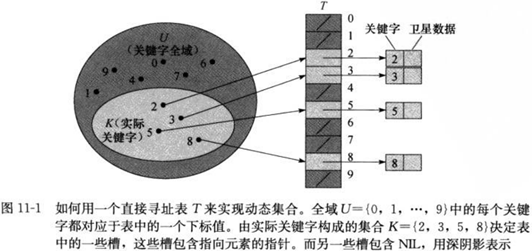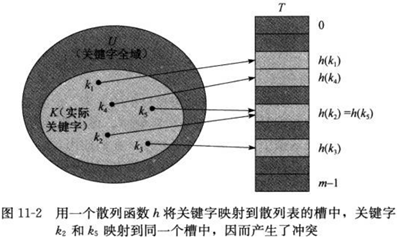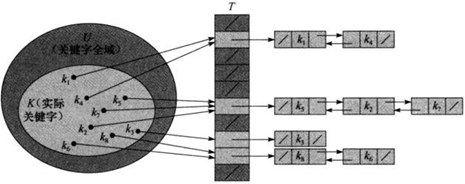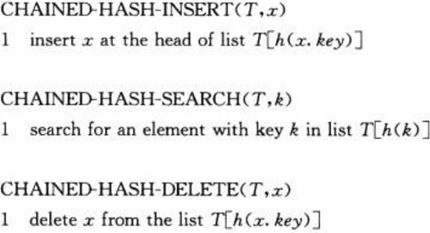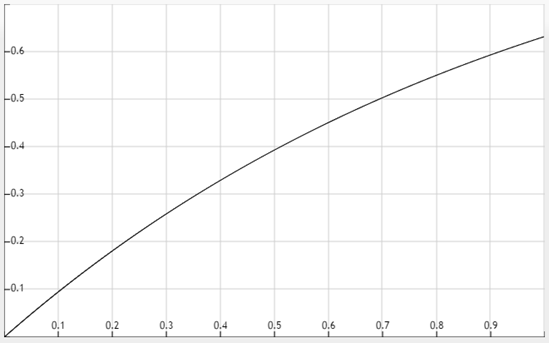散列表(hash table)——算法导论(13)
1. 引言
许多应用都需要动态集合结构,它至少需要支持Insert,search和delete字典操作。散列表(hash table)是实现字典操作的一种有效的数据结构。
2. 直接寻址表
在介绍散列表之前,我们先介绍直接寻址表。
当关键字的全域U(关键字的范围)比较小时,直接寻址是一种简单而有效的技术。我们假设某应用要用到一个动态集合,其中每个元素的关键字都是取自于全域U={0,1,…,m-1},其中m不是一个很大的数。另外,假设每个元素的关键字都不同。
为表示动态集合,我们用一个数组,或称为直接寻址表(direct-address table),记为T[0~m-1],其中每一个位置(slot,槽)对应全域U中的一个关键字,对应规则是,槽k指向集合中关键字为k的元素,如果集合中没有关键字为k的元素,则T[k]=NIL。
几种字典操作实现起来非常简单:
上述的每一个操作的时间均为O(1)时间。
在某些应用中,我们其实可以把对象作为元素直接保存在寻址表的槽中,而不需要像上图所示使用指针指向该对象,这样可以节省空间。
3. 散列表
我们可以看出,直接寻址技术有几个明显的缺点:如果全域U很大,那么表T 将要申请一段非常长的空间,很可能会申请失败;对于全域较大,但是元素却十分稀疏的情况,使用这种存储方式将浪费大量的存储空间。
为了克服直接寻址技术的缺点,而又保持其快速字典操作的优势,我们可以利用散列函数(hash function)
h:U→{0,1,2,…,m-1}
来计算关键字k所在的的位置,简单的讲,散列函数h(k)的作用是将范围较大的关键字映射到一个范围较小的集合中。这时我们可以说,一个具有关键字k的元素被散列到槽h(k)上,或者说h(k)是关键字k的散列值。
示意图如下:
这时会产生一个问题:两个关键字可能映射到同一槽中(我们称之为冲突(collision)),并且不管你如何优化h(k)函数,这种情况都会发生(因为|U|>m)。
因此我们现在面临两个问题,一是遇到冲突时如何解决;二是要找出一个的函数h(k)能够尽量的减少冲突;
我们先来解决第一个问题。
解决办法就是,我们把同时散列到同一槽中的元素以链表的形式“串联”起来,而该槽中保存的是指向该链表的指针。如下图所示:
采用该解决办法后,我们可以通过如下的操作方式来进行字典操作:
下面我们来分析上图各操作的性能。
首先是插入操作,很明显时间为O(1)。
然后分析删除操作,其花费的时间相当于从链表中删除一个元素的时间:如果链表T[h(k)]是双链表,花费的时间为O(1);如果链表T[h(k)]是单链表,则花费的时间和查找操作的渐进运行时间相同。
下面我们重点分析查找运行时间:
首先,我们假定任何一个给定元素都等可能地散列在散列表T的任何一个槽位中,且与其他元素被散列在T的哪个位置无关。我们称这个假设为简单均匀散列(simple uniform hashing)。
不失一般性,我们设散列表T的m个槽位散列了n个元素,则平均每个槽位散列了α = n/m个元素,我们称α为T的装载因子(load factor)。我们记位于槽位j的链表为T[j](j=1,2,…,m-1),而nj表示链表T[j]的长度,于是有
n = n0+n1+…+nm-1,
且E[nj] = α = n / m。
现在我们分查找成功和查找不成功两种情况讨论。
① 查找不成功
在查找不成功的情况下,我们需要遍历链表T[j]的每一个元素,而链表T[j]的长度是α,因此需要时间O(α),加上索引到T(j)的时间O(1),总时间为θ(1 + α)。
② 查找成功
在查找成功的情况下,我们无法准确知道遍历到链表T[j]的何处停止,因此我们只能讨论平均情况。
我们设xi是散列表T的第i个元素(假设我们按插入顺序对散列表T中的n个元素进行了1~n的编号),ki表示xi.key,其中i = 1,2,…,n,再定义随机变量Xij=I{h(ki)=h(kj)},即:
在简单均匀散列的假设下有
P{h(ki)=h(kj)} = 1 / m,
E[Xij] = 1 / m。
则所需检查的元素的数目的期望是:
因此,一次成功的检查所需要的时间是O(2 + α / 2 –α / 2n) = θ(1 + α)。
综合上面的分析,在平均下,全部的字典操作都可以在O(1)时间下完成。
4. 散列函数
现在我们来解决第二个问题:如何构造一个好的散列函数。
一个好的散列函数应(近似地)满足简单均匀散列:每个关键字都等可能的被散列到各个槽位,并与其他关键字散列到哪一个槽位无关(但很遗憾,我们一般无法检验这一条件是否成立)。
在实际应用中,常常可以可以运用启发式方法来构造性能好的散列函数。设计过程中,可以利用关键字分布的有用信息。一个好的方法导出的散列值,在某种程度上应独立于数据可能存在的任何模式。
下面给出两种基本的构造散列函数的方法:
除法散列法的做法很简单,就是让关键字k去除以一个数m,取余数,这样就将k映射到m个槽位中的某一个,即散列函数是:
h(k) = k mod m ,
由于只做一次除法运算,该方法的速度是非常快的。但应当注意的是,我们在选取m的值时,应当避免一些选取一些值。例如,m不应是2的整数幂,因为如果m = 2 ^ p,则h(k)就是k的p个最低位数字。除非我们已经知道各种最低p位的排列是等可能的,否则我们最好慎重的选择m。而一个不太接近2的整数幂的素数,往往是较好的选择。
该方法包含两个步骤。第一步:用关键字k乘以A(0 < A < 1),并提取kA的小数部分;第二步:用m乘以这个值,在向下取整,即散列函数是:
h(k) = [m (kA mod 1)],
这里“kA mod 1”的是取kA小数部分的意思,即kA –[kA]。
乘法散列法的一个优点是,一般我们对m的选择不是特别的关键,一般选择它为2的整数幂即可。虽然这个方法对任意的A都适用,但Knuth认为,A ≈ (√5 - 1)/ 2 = 0.618033988…是一个比较理想的值
(5) 布隆过滤器
布隆过滤器(Bloom Filter)是一种常被用来检验一个元素是否在一个集合里面的算法(从这里我们可以看出,这个集合只需要保存比对元素的“指纹”即可,而不需要保存比对元素的全部信息),由一个很长的二进制向量和一系列随机映射函数组成。相较于其他算法,它具有空间利用率高,检测速度快等优点。
在介绍布隆过滤器之前,我们先假设这样一种场景:某公司致力于解决用户常常遭遇骚扰电话的问题。该公司打算建立一个骚扰电话号码的黑名单,即把所有骚扰电话的号码保存到一张hash表中。当用户接到某个陌生电话时,服务器会立即将该号码与黑名单进行比对,若比对成功,则对该号码进行拦截。
他们当然不会直接将骚扰电话号码保存在hash表中,而是对每一个号码利用某种算法进行数据压缩,最终得到一个8字节的信息指纹,然后将其存入表中。但即便如此,问题还是来了:由于hash表的空间利用率大约只有50%,等价换算过来,储存一个号码将要花费16字节的空间。按照这样计算,储存1亿个号码将要花费大约1.6G的空间,储存几十亿的号码可能需要上百G的空间。那么有没有更好解决办法呢?
这时,布隆过滤器就派上用场了。假设我们有1亿条骚扰电话号码需要记录,我们的做法是,首先建立一个2亿字节(即16亿位,并假设我们对这16亿位以1~16亿的顺序进行了编号)的向量,将每位都置为0。当要插入某个电话号码x时,我们使用某种算法(该算法可以做到每个位被映射的概率是一样的,且某个映射的分布与其他的映射分布无关)让号码x映射到1~16亿中的8个位上,然后把这8个位设为1。当查找时,利用同样的方法将号码映射到8个位上,若这8个位都为1,则说明该号码在黑名单中,否则就不在。
我们可以发现,布隆过滤器的做法在思想上和hash函数将关键字映射到hash表的做法很相似,因此布隆过滤器也会遇到冲突问题,这会导致将一个“好”的号码误判为骚扰号码(但绝对不会将骚扰号码误判为一个“好”的号码)。下面我们通过计算来证明,在大多数情况和场景中,这种误判我们是可以忍受的。
假设某布隆过滤器共有的m个槽位,我们要把n个号码添加到其中,而每个号码会映射k个槽位。那么,添加这n个号码将会产生kn次映射。因为这m个槽位中,每个槽被映射到的概率是相等的。因此,
在一次映射中,某个槽位被映射到的概率(即该槽位值为1的概率)为
该槽位值为0的概率为

经过kn次映射后,某个槽值为0的概率为
为1的概率为
所以,误判(k个槽位均为1)的概率就为
这时我们注意到,当k=1时,情况就就变成了hash table的情况,
根据自变量的不同我们分以下两种方式讨论:
① 我们把误判率p看作关于装载因子α的函数(k看作常数),这时我们从函数![]() 的函数图像
的函数图像
中可以得出一下结论:
随着装载因子α(α = n / m)的增大,误判率(或者是产生冲突的概率)也将增大,但增长速度逐渐减慢。
要使误判率小于0.5,装载因子必须小于0.7。这也从某种程度上解释了为什么JDK HashMap的装载因子默认是0.75。
② 我们把误判率p看作关于k的函数(α作为常数),通过对p求导分析,我们发现,当k=ln2 / α时,误判率p取得最小值。此时,p = 2^(-k)(或者k = – ln p / ln 2),这个结论让我们能够根据可以忍受的误判率计算出最为合适的k值。
下面给出一个BloomFilter的Java实现代码(来自:https://github.com/MagnusS/Java-BloomFilter,只是把其中的变量和方法名换成了上文提及的):
public class BloomFilter<E> implements Serializable { private static final long serialVersionUID = -9077350041930475408L; private BitSet bitset;// 二进制向量 private int slotSize; // 二进制向量的总位(槽)数(文中的m) private double loadFactor; // 装载因子 (文中的α) private int capacity; // 布隆过滤器的容量(文中的n) private int size; // 装载的数目 private int k; // 一个元素对应的位数(文中的k) static final Charset charset = Charset.forName("UTF-8"); static final String hashName = "MD5";// 默认采用MD5算法,也可改为SHA1 static final MessageDigest digestFunction; static { MessageDigest tmp; try { tmp = java.security.MessageDigest.getInstance(hashName); } catch (NoSuchAlgorithmException e) { tmp = null; } digestFunction = tmp; } public BloomFilter(int slotSize, int capacity) { this(slotSize / (double) capacity, capacity, (int) Math.round((slotSize / (double) capacity) * Math.log(2.0))); } public BloomFilter(double falsePositiveProbability, int capacity) { this(Math.log(2) / (Math.ceil(-(Math.log(falsePositiveProbability) / Math.log(2)))),//loadFactor = ln2 / k; capacity, // (int) Math.ceil(-(Math.log(falsePositiveProbability) / Math.log(2)))); //k = -ln p / ln2 } public BloomFilter(int slotSize, int capacity, int size, BitSet filterData) { this(slotSize, capacity); this.bitset = filterData; this.size = size; } public BloomFilter(double loadFactor, int capacity, int k) { size = 0; this.loadFactor = loadFactor; this.capacity = capacity; this.k = k; this.slotSize = (int) Math.ceil(capacity * loadFactor); this.bitset = new BitSet(slotSize); } public static int createHash(String val, Charset charset) { return createHash(val.getBytes(charset)); } public static int createHash(String val) { return createHash(val, charset); } public static int createHash(byte[] data) { return createHashes(data, 1)[0]; } public static int[] createHashes(byte[] data, int hashes) { int[] result = new int[hashes]; int k = 0; byte salt = 0; while (k < hashes) { byte[] digest; synchronized (digestFunction) { digestFunction.update(salt); salt++; digest = digestFunction.digest(data); } for (int i = 0; i < digest.length / 4 && k < hashes; i++) { int h = 0; for (int j = (i * 4); j < (i * 4) + 4; j++) { h <<= 8; h |= ((int) digest[j]) & 0xFF; } result[k] = h; k++; } } return result; } /** * Compares the contents of two instances to see if they are equal. * * @param obj * is the object to compare to. * @return True if the contents of the objects are equal. */ @Override public boolean equals(Object obj) { if (obj == null) { return false; } if (getClass() != obj.getClass()) { return false; } final BloomFilter<E> other = (BloomFilter<E>) obj; if (this.capacity != other.capacity) { return false; } if (this.k != other.k) { return false; } if (this.slotSize != other.slotSize) { return false; } if (this.bitset != other.bitset && (this.bitset == null || !this.bitset.equals(other.bitset))) { return false; } return true; } /** * Calculates a hash code for this class. * * @return hash code representing the contents of an instance of this class. */ @Override public int hashCode() { int hash = 7; hash = 61 * hash + (this.bitset != null ? this.bitset.hashCode() : 0); hash = 61 * hash + this.capacity; hash = 61 * hash + this.slotSize; hash = 61 * hash + this.k; return hash; } /** * Calculates the expected probability of false positives based on the * number of expected filter elements and the size of the Bloom filter. * <br /> * <br /> * The value returned by this method is the <i>expected</i> rate of false * positives, assuming the number of inserted elements equals the number of * expected elements. If the number of elements in the Bloom filter is less * than the expected value, the true probability of false positives will be * lower. * * @return expected probability of false positives. */ public double expectedFalsePositiveProbability() { return getFalsePositiveProbability(capacity); } /** * Calculate the probability of a false positive given the specified number * of inserted elements. * * @param numberOfElements * number of inserted elements. * @return probability of a false positive. */ public double getFalsePositiveProbability(double numberOfElements) { // (1 - e^(-k * n / m)) ^ k return Math.pow((1 - Math.exp(-k * (double) numberOfElements / (double) slotSize)), k); } /** * Get the current probability of a false positive. The probability is * calculated from the size of the Bloom filter and the current number of * elements added to it. * * @return probability of false positives. */ public double getFalsePositiveProbability() { return getFalsePositiveProbability(size); } /** * Returns the value chosen for K.<br /> * <br /> * K is the optimal number of hash functions based on the size of the Bloom * filter and the expected number of inserted elements. * * @return optimal k. */ public int getK() { return k; } /** * Sets all bits to false in the Bloom filter. */ public void clear() { bitset.clear(); size = 0; } /** * Adds an object to the Bloom filter. The output from the object's * toString() method is used as input to the hash functions. * * @param element * is an element to register in the Bloom filter. */ public void add(E element) { add(element.toString().getBytes(charset)); } /** * Adds an array of bytes to the Bloom filter. * * @param bytes * array of bytes to add to the Bloom filter. */ public void add(byte[] bytes) { int[] hashes = createHashes(bytes, k); for (int hash : hashes) bitset.set(Math.abs(hash % slotSize)); size++; } /** * Adds all elements from a Collection to the Bloom filter. * * @param c * Collection of elements. */ public void addAll(Collection<? extends E> c) { for (E element : c) add(element); } /** * Returns true if the element could have been inserted into the Bloom * filter. Use getFalsePositiveProbability() to calculate the probability of * this being correct. * * @param element * element to check. * @return true if the element could have been inserted into the Bloom * filter. */ public boolean contains(E element) { return contains(element.toString().getBytes(charset)); } /** * Returns true if the array of bytes could have been inserted into the * Bloom filter. Use getFalsePositiveProbability() to calculate the * probability of this being correct. * * @param bytes * array of bytes to check. * @return true if the array could have been inserted into the Bloom filter. */ public boolean contains(byte[] bytes) { int[] hashes = createHashes(bytes, k); for (int hash : hashes) { if (!bitset.get(Math.abs(hash % slotSize))) { return false; } } return true; } /** * Returns true if all the elements of a Collection could have been inserted * into the Bloom filter. Use getFalsePositiveProbability() to calculate the * probability of this being correct. * * @param c * elements to check. * @return true if all the elements in c could have been inserted into the * Bloom filter. */ public boolean containsAll(Collection<? extends E> c) { for (E element : c) if (!contains(element)) return false; return true; } /** * Read a single bit from the Bloom filter. * * @param bit * the bit to read. * @return true if the bit is set, false if it is not. */ public boolean getBit(int bit) { return bitset.get(bit); } /** * Set a single bit in the Bloom filter. * * @param bit * is the bit to set. * @param value * If true, the bit is set. If false, the bit is cleared. */ public void setBit(int bit, boolean value) { bitset.set(bit, value); } /** * Return the bit set used to store the Bloom filter. * * @return bit set representing the Bloom filter. */ public BitSet getBitSet() { return bitset; } /** * Returns the number of bits in the Bloom filter. Use count() to retrieve * the number of inserted elements. * * @return the size of the bitset used by the Bloom filter. */ public int slotSize() { return slotSize; } /** * Returns the number of elements added to the Bloom filter after it was * constructed or after clear() was called. * * @return number of elements added to the Bloom filter. */ public int size() { return size; } /** * Returns the expected number of elements to be inserted into the filter. * This value is the same value as the one passed to the constructor. * * @return expected number of elements. */ public int capacity() { return capacity; } /** * Get expected number of bits per element when the Bloom filter is full. * This value is set by the constructor when the Bloom filter is created. * See also getBitsPerElement(). * * @return expected number of bits per element. */ public double getLoadFactor() { return this.loadFactor; } }
